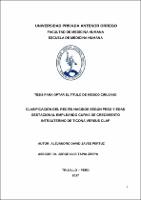Mostrar el registro sencillo del ítem
Clasificación del recién nacidos según peso y edad gestacional empleando curva de crecimiento intrauterino de ticona versus clap
| dc.contributor.advisor | Tapia Zerpa, Jorge Luis | |
| dc.contributor.author | Javes Pertuz, Alejandro David | |
| dc.creator | Javes Pertuz, Alejandro David | |
| dc.date.accessioned | 2017-09-15T16:02:55Z | |
| dc.date.available | 2017-09-15T16:02:55Z | |
| dc.date.issued | 2017 | |
| dc.identifier | T_MED_2184 | |
| dc.identifier.other | T046_46824206 | |
| dc.identifier.uri | https://hdl.handle.net/20.500.12759/2976 | |
| dc.description.abstract | El peso al nacimiento es la variable antropométrica de mayor uso a nivel mundial para la evaluación intrauterina. Sin embargo, el peso al nacer considerado como único criterio de juicio en la valoración perinatal es insuficiente, siendo necesario relacionarlo con la edad gestacional, a esto se le llama adecuación del peso para la edad gestacional, la cual tiene un mayor valor pronóstico que el peso por sí solo, y para determinarla son necesarias las curvas de crecimiento intrauterino. Objetivo: Determinar si existe diferencia en la clasificación del recién nacido según el peso y la edad gestacional empleando la curva de crecimiento intrauterino de Ticona y la del CLAP. Material y métodos: Se realizó un estudio observacional, transversal, retrospectivo. Para el mismo se revisó una muestra total de 673 historias clínicas neonatales los cuales nacieron en el Hospital Belén de Trujillo en el año 2016 y que cumplieron con los criterios de selección. Posteriormente se evaluó los datos empleando la curva del CLAP y la Ticona tomando en cuenta los factores de corrección de esta última. Resultados: De los 673 pacientes empleando la curva de Ticona, 479 recién nacidos del estudio eran adecuados para edad gestacional (71,2%), 89 sujetos eran grandes para edad gestacional (13,2%) y 105 pequeños para edad gestacional (15,6%); empleando la curva de CLAP, 528 recién nacidos del estudio eran adecuados para edad gestacional (78,5%), 74 sujetos eran grandes para edad gestacional (9,5%) y 81 sujetos eran pequeños para edad gestacional (12,0 %). Al aplicar la prueba de Chi-cuadrado tenemos que los resultados obtenidos con ambas curvas presentan diferencias altamente Significativa (p= 0.00837 < 0.05). Conclusiones: Los resultados varían significativamente dependiendo de la curva empleada en el análisis del recién nacido, debido a que la curva del CLAP no tomó en cuenta los 4 factores de corrección que halló Ticona, estos son: sexo del neonato, la talla de la madre, la región natural y la paridad materna; los cuales actúan como variables intervinientes en la evaluación del recién nacido; es por eso que lo mejor es emplear curvas creadas en cada establecimiento perinatológico tomando en cuenta estos factores de corrección. | es_PE |
| dc.description.abstract | Birthweight is the most widely used anthropometric variable in the world for intrauterine nutritional assessment. However, birth weight considered as the only criterion of judgment in perinatal assessment is insufficient, being necessary to relate it to gestational age, this is called weight adequacy for gestational age, which has a higher prognostic value than the Weight per se, and to determine this, intrauterine growth curves are necessary Objective: To determine if there is difference in the classification of the newborn according to birthweight and gestational age using the intrauterine growth curve of Ticona and CLAP. Material and methods: An observational, transversal, retrospective study was performed. For the same, a total sample of 673 neonatal clinical records were reviewed, which were born at Hospital Belen - Trujillo in 2016 and met the selection criteria. The data were then evaluated using the curve of CLAP and Ticona, taking into account the Ticona`s correction factors. Results: Of the 673 patients using the Ticona curve, 479 newborns in the study were appropiate for gestational age (71.2%), 89 subjects were large for gestational age (13.2%) and 105 were small for gestational age (15.6 %); using the CLAP curve, 528 infants were suitable for gestational age (78.5%), 74 subjects were large for gestational age (9.5%) and 81 subjects were small for gestational age (12.0%). When applying the Chi-square test we have that the results obtained with both curves present highly significant differences (p = 0.00837 <0.05). Conclusions: The results vary significantly depending on the curve used in the analysis of the newborn, because the CLAP curve did not take into account the 4 correction factors that Ticona found, such as: sex of the newborn, size of the mother, Natural region and maternal parity; Which act as intervening variables in the evaluation of the newborn; That is why it is best to use curves created in each perinatological establishment taking into account these factors of correction. | en_US |
| dc.format | application/pdf | es_PE |
| dc.language.iso | spa | es_PE |
| dc.publisher | Universidad Privada Antenor Orrego - UPAO | es_PE |
| dc.relation.ispartofseries | T_MED_2184 | |
| dc.rights | info:eu-repo/semantics/openAccess | es_PE |
| dc.source | Universidad Privada Antenor Orrego - UPAO | es_PE |
| dc.source | Repositorio institucional - UPAO | es_PE |
| dc.subject | Curva de Crecimiento Intrauterino | es_PE |
| dc.subject | Edad Gestacional | es_PE |
| dc.title | Clasificación del recién nacidos según peso y edad gestacional empleando curva de crecimiento intrauterino de ticona versus clap | es_PE |
| dc.type | info:eu-repo/semantics/bachelorThesis | es_PE |
| thesis.degree.level | Título Profesional | es_PE |
| thesis.degree.grantor | Universidad Privada Antenor Orrego. Facultad de Medicina Humana | es_PE |
| thesis.degree.name | Médico Cirujano | es_PE |
| thesis.degree.discipline | Medicina | es_PE |
Ficheros en el ítem
Este ítem aparece en la(s) siguiente(s) colección(es)
-
Medicina Humana [2739]

